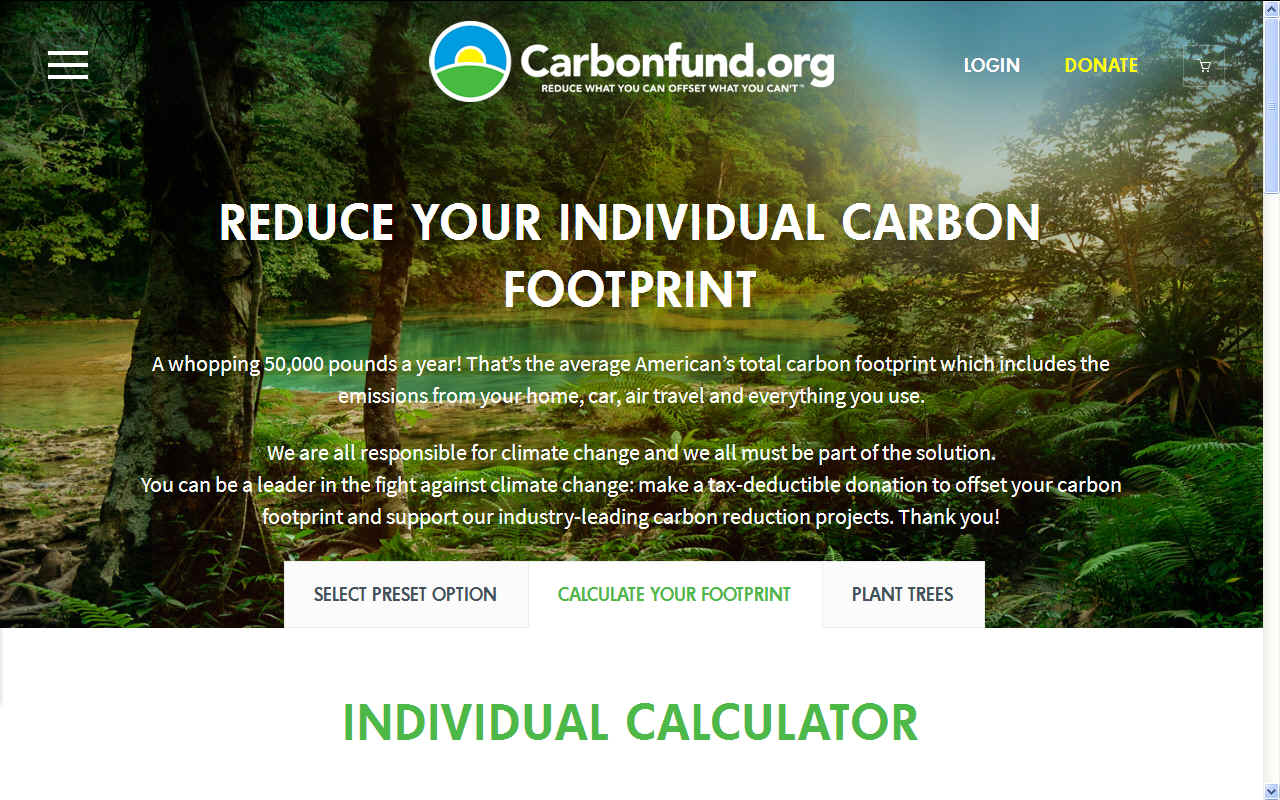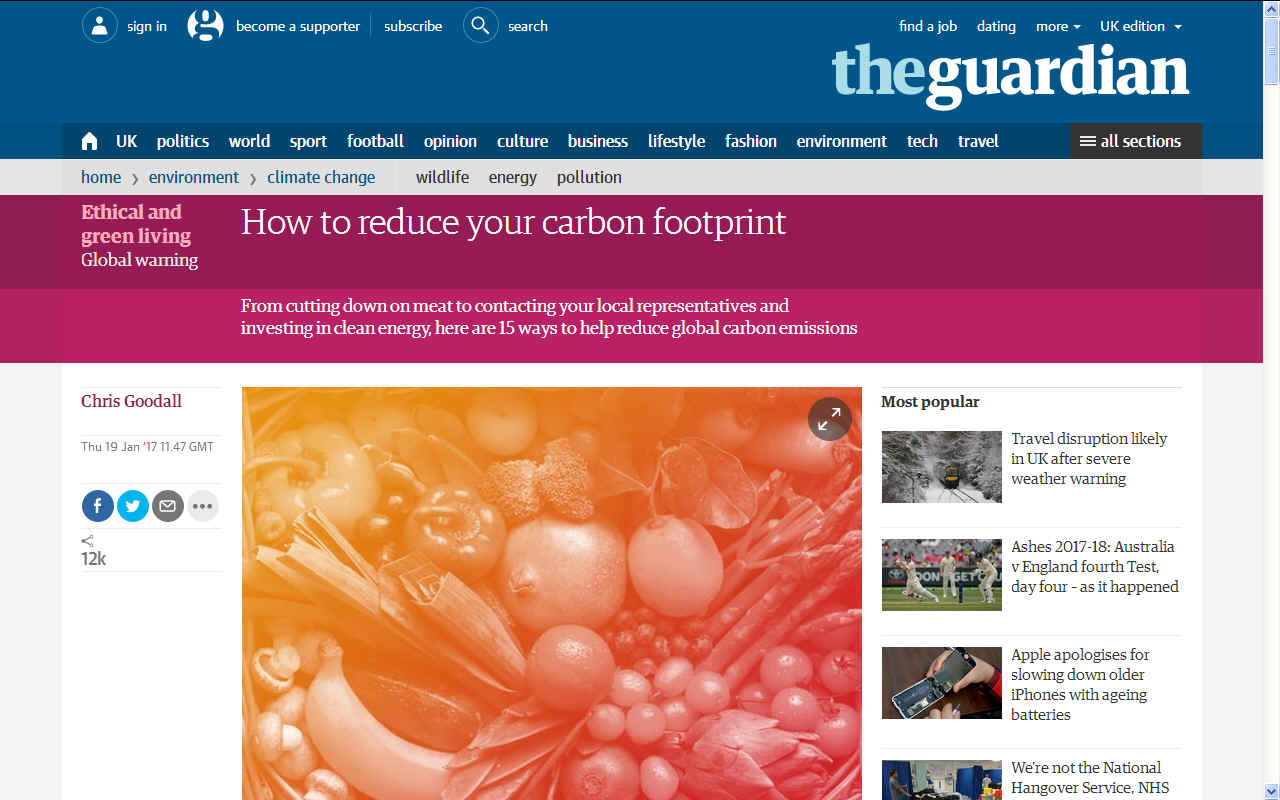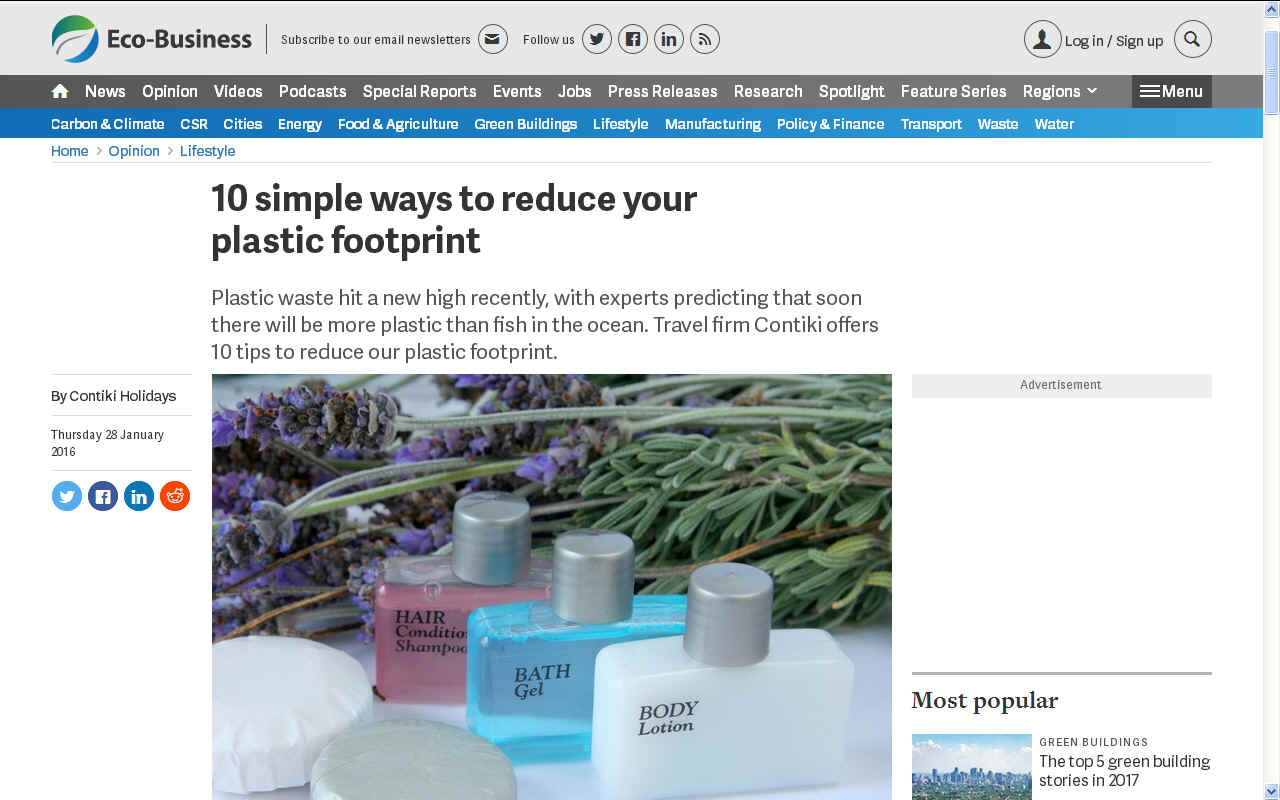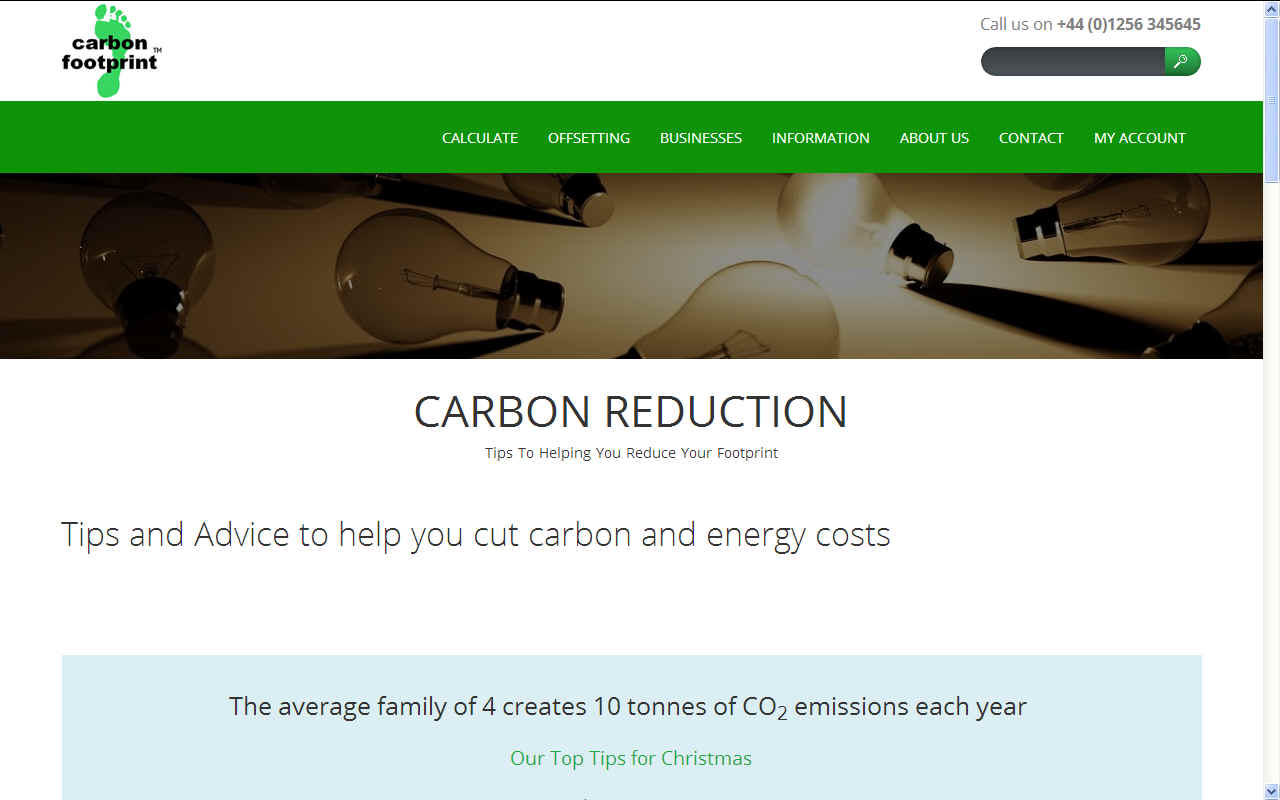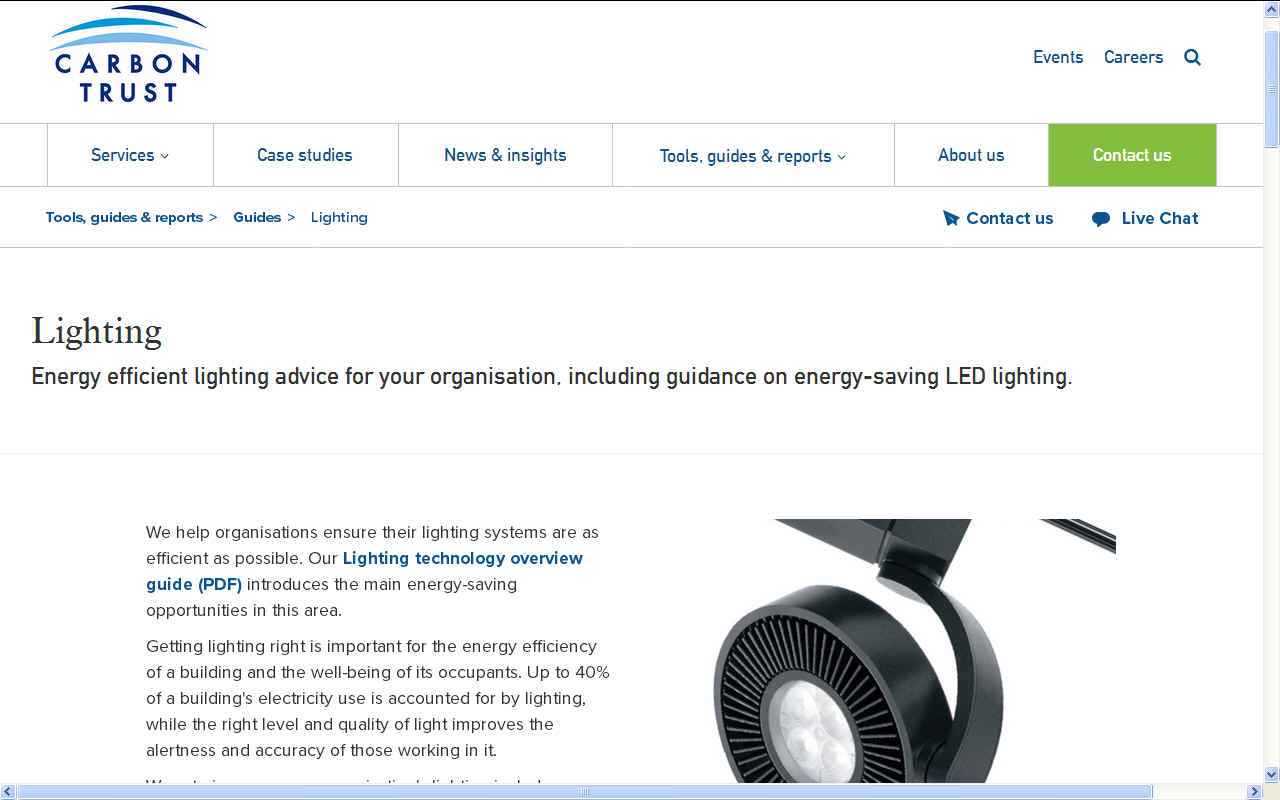|
CARBON FOOTPRINTS
|
|
|
CARBON FUND USA - The average U.S. household carbon footprint is about 50 tons CO2e per year. The single largest source of emissions for the typical household is from driving (gasoline use). Transportation as a whole (driving, flying & small amount from public transit) is the largest overall category, followed by housing (electricity, natural gas, waste, construction) then food (mostly from red meat, dairy and seafood products, but also includes emissions from all other food), then goods followed lastly by services. The carbon footprint of U.S. households is about 5 times greater than the global average, which is approximately 10 tons CO2 per household per year. For most U.S. households, the single most important action to reduce their carbon footprint is driving less or switching to a more efficient vehicle. You may have worked out that Donald Trump knows how badly behaved his country is and how hard it would be for his countrymen to give up their energy greedy habits. Presumably, the US president would much rather allow other countries to pay for their exploitation of the natural world and look the other way while the polar ice caps melt. It may be immoral, but it is legal. Trade sanctions may be one way of helping US citizens see the light, perhaps starting with oil exports. Why not? Are they not trying to prevent North Korea from developing nuclear weapons using sanctions. Without oil imports the US would have to go green sooner.
Q. How big is your carbon footprint and what does that mean?
A. It means how much carbon dioxide do you produce to live. Or, if you are a manufacturer, how much CO2 are you making during the manufacturing process and what steps are you taking to reduce your output.
In your everyday life you can take steps to reduce your energy consumption. There are many tips on this page as to how to do so and there are many other sites with more information about this subject.
If you manufacture goods that take a lot of energy to make, then you can help us to spread the news about reducing your energy needs. As a country, the United Kingdom is a long way off meeting the targets set by the Climate Change Act 2008. We are lobbying locally to try to change that where the snowy winter we expected for 2017 was actually a flood of non-stop rain that was unseasonably warm.
HOW
CAN WE HELP ?
The Cleaner Ocean Foundation aims to conduct ocean research using as little fossil fuel generated energy as possible.
FIVE
NO-COST WAYS TO SAVE ENERGY
Turn off all other electrical equipment when not in use to multiply the savings.
PLANT A TREE - Carbon Footprints can be reduced through the development of alternative projects, such as solar and wind energy, which are environment friendly, renewable resources, or reforestation, the restocking of existing forests or woodlands that have previously been depleted. These examples are known as Carbon Offsetting, the counteracting of carbon dioxide emissions with an equivalent reduction of carbon dioxide in the atmosphere. We should build more wooden houses.
BETTER DRIVING – Studies have shown up to 30% of the difference in miles per gallon (MPG) is due to driving habits alone. You could save more than a ton of CO2 per year by:
1 Air travel is usually the largest component of the carbon footprint of frequent flyers. A single return flight from London to New York – including the complicated effects on the high atmosphere – contributes to almost a quarter of the average person’s annual emissions. The easiest way to make a big difference is to go by train or not take as many flights.
2 The second most important lifestyle change is to eat less meat, with particular emphasis on meals containing beef and lamb. Cows and sheep emit large quantities of methane, a powerful global warming gas. A vegan diet might make as much as a 20% difference to your overall carbon impact but simply cutting out beef will deliver a significant benefit on its own.
3 Home heating is next. Poorly insulated housing requires large quantities of energy to heat. If you have properly insulated the loft and filled the cavity wall, the most important action you can take is to draught-proof the house, something you can do yourself. Those with solid brick or stone walls will also benefit from adding insulation, but the financial benefits are unlikely to cover the cost of doing the work, over time.
4 Old gas and oil boilers can be hugely wasteful. Even if your current boiler is working well, it’s worth thinking about a replacement if it is more than 15 years old. Your fuel use may fall by a third or more, repaying the cost in lower fuel bills.
5 The distance you drive matters. Reducing the mileage of the average new car from 15,000 to 10,000 miles a year will save more than a tonne of CO2, about 15% of the average person’s footprint. If car travel is vital, think about leasing an electric vehicle when your existing car comes to the end of its life. A battery car will save you money on fuel, particularly if you drive tens of thousands of miles a year. Even though the electricity to charge your car will be partly generated in a gas or coal power station, electric vehicles are so much more efficient that total CO2 emissions will fall.
6 But bear in mind that the manufacture of an electric car may produce more emissions than the vehicle produces in its lifetime. Rather than buying a new electric vehicle, it may be better to keep your old car on the road by maintaining it properly and using it sparingly. The same is true for many other desirable items; the energy needed to make a new computer or phone is many times the amount used to power it over its lifetime. Apple says 80% of the carbon footprint of a new laptop comes from manufacturing and distribution, not use in the home.
7 Within the last couple of years, LEDs (light-emitting diodes) have become cheap and effective. If you have any energy-guzzling halogen lights in your house – many people have them in kitchens and bathrooms – it makes good financial and carbon sense to replace as many as possible with their LED equivalents. They should last at least 10 years, meaning you avoid the hassle of buying new halogen bulbs every few months. Not only will your CO2 footprint fall, but because LEDs are so efficient, you will also help reduce the need for national grids to turn on the most expensive and polluting power stations at peak demand times on winter evenings.
8 Home appliances. Frequent use of a tumble dryer will add to your energy bill to an extent that may surprise you. But when buying a new appliance, don’t assume you will benefit financially from buying the one with the lowest level of energy consumption. There’s often a surprising premium to really efficient fridges or washing machines.
9 Consume less. Simply buying less stuff is a good route to lower emissions. A suit made of wool may have a carbon impact equivalent to your home’s electricity use for a month. A single T-shirt may have caused emissions equal to two or three days’ typical power consumption. Buying fewer and better things has an important role to play.
10 The CO2 impact of goods and services is often strikingly different from what you’d expect. Mike Berners-Lee’s book How Bad Are Bananas? takes an entertaining and well-informed look at what really matters. Bananas, for example, are fine because they are shipped by sea. But organic asparagus flown in from Peru is much more of a problem.
11 Invest in your own sources of renewable energy. Putting solar panels on the roof still usually makes financial sense, even after most countries have ceased to subsidise installation. Or buy shares in new cooperatively owned wind, solar or hydroelectric plants that are looking for finance. The financial returns won’t be huge – perhaps 5% a year in the UK, for example – but the income is far better than leaving your money in a bank.
12 Buy from companies that support the switch to a low-carbon future. An increasing number of businesses are committed to 100% renewable energy. Unilever, the global consumer goods business, says its operations will be better than carbon-neutral by 2030. Those of us concerned about climate change should buy from businesses acting most aggressively to reduce their climate impact.
13 For a decade, investors ignored the movement that advocated the divestment of holdings in fossil fuel companies. Large fuel companies and electricity generation businesses were able to raise the many billions of new finance they needed. Now, by contrast, money managers are increasingly wary of backing the investment plans of oil companies and switching to renewable projects. And universities and activist investors around the world are selling their holdings in fossil fuels, making it more difficult for these companies to raise new money. Vocal support for those backing out of oil, gas and coal helps keep up the pressure.
14 Politicians tend to do what their electorates want. The last major UK government survey showed that 82% of people supported the use of solar power, with only 4% opposed. A similar survey in the US showed an even larger percentage in favour. The levels of support for onshore wind aren’t much lower, either in the US or the UK. We need to actively communicate these high levels of approval to our representatives and point out that fossil fuel use is far less politically popular.
15 Buy gas and electricity from retailers who sell renewable power. This helps grow their businesses and improves their ability to provide cost-competitive fuels to us. Renewable natural gas is just coming on to the market in reasonable quantities in many countries and fossil-free electricity is widely available. Think about switching to a supplier that is working to provide 100% clean energy.
ECO BUSINESS - 10 ways to reduce your plastic footprint. Plastic waste hit a new high recently, with experts predicting that soon there will be more plastic than fish in the ocean. Travel firm Contiki offers 10 tips to reduce our plastic footprint. The problem with an issue as huge as the global plastic epidemic, is where do you begin? The statistics around plastic pollution speak for themselves and are impossible to ignore – 500 billion plastic bags used annually, 5 trillion pieces of plastic floating in our oceans, one million sea birds killed annually from plastic ingestion or entanglement. One way of spreading the news about how to reduce your plastic consumption is with an application for a mobile phone. We are doing the same, producing a free download for Android and iOS mobile devices.
HOW
CAN YOU HELP ?
Carbon literacy is one of the weapons in our armoury to combat climate change. Our awareness campaigns are based on reason, seeking to define the facts and separate them from fiction and spin - to enable us to find common ground on which to build a society that can comfortably support life on earth on firm ethical and moral terms. By supporting us our associates and partners are contributing to essential research that may guide corporations and policy makers as to what is promising and the appropriate remedies that could be available, made possible by our increasing knowledge of technology and the state and pace of development that is considered necessary to halt global warming.
Why not consider changing from red meat to poultry, from poultry to fish and from fish to vegetables and grains, or you might go the whole hog and become a vegan.
IT'S
OUR FAULT AND OUR JOB TO PUT THINGS RIGHT
Please help us if you can.
CARBON FOOTPRINT LTD - One way of spreading the news about how to reduce your energy consumption is with an application for a mobile phone. We are doing the same, producing a free download for Android and iOS mobile devices. If electricity is responsible for roughly 37% of Carbon Dioxide emissions, then fitting photovoltaic panels to replace electricity use at home and in the factory could do the planet a big favour.
LIGHTING - Fit LED bulbs and replacement lights wherever possible. They use at least 75% less energy and last up to 25 times longer. Compact fluorescents save more than 2/3rds the amount of energy of regular light bulbs.
COMPUTING - Use a laptop instead of a work station. Laptops, unlike desktop computers, are designed to be energy-efficient, because battery life is a major factor to laptop design. According to Energy Star, a laptop can be up to 80% more energy-efficient than a desktop. Energy-efficient LCD screens, hard drives, CPUs and adaptors all factor into making makes laptops much better tools for the planet.
LINKS & REFERENCE
https://www.carbontrust.com/ https://www.theguardian.com/environment/2017/jan/19/how-to-reduce-carbon-footprint https://www.carbonfootprint.com/ https://carbonfund.org/calculate-your-footprint/
|
|
|
Click the links on this page or see our SITE INDEX to navigate this site. Copyright © 2018 Cleaner Oceans Foundation.
|
